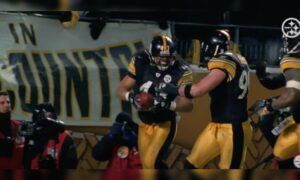For many, no doubt, it seems as though it has taken a longer time than it should have, but it does appear that the Pittsburgh Steelers are finally in the process of putting together an offense around quarterback Ben Roethlisberger that can legitimately carry the team through the season.
It follows somewhat the trajectory of the Steelers dynasty of the 70s, which built its foundation around the Steel Curtain and defensive dominance, only to gradually morph into a more offensive-oriented team around Hall of Fame quarterback Terry Bradshaw.
The ability to successfully transition from one strength to another is what helped the Steelers claim four championships within the six-year span, and the current iteration of the team is hoping to resurrect its Super Bowl window on the back nine of Roethlisberger’s career with its own offensive might as the defense has taken a back seat.
Of course, the comparisons are not a perfect analogy. In the context of the era, the Steelers’ defense of the 70s certainly never fell off to anywhere near the degree that we have seen from the current unit’s displays over the past three seasons.
And though it took time for the aerial game to emerge, Pittsburgh’s running game for the mid-70s Super Bowl trophies was certainly very much in place. But then again it will never truly be fair to compare that era of the Steelers with just about any era of any other team in the league, such is the legacy that they’ve left behind.
In general, however, it is true that the Steelers of the late 70s were a team transitioning to a pass-oriented offense that was beginning to have to compensate for its aging stars on defense, who would shortly begin to retire. By then, only half of the Steel Curtain was still in place as it was, with Ernie Holmes gone by 1978 and Dwight White no longer a starter toward the end of that season.
In today’s NFL, however, it’s more difficult in the free agency era to sustain success through personnel shifts as your star players age, and the Steelers are seeing that now, with nearly all the key cogs of their recent Super Bowls having been replaced with less proven talent.
Offensively, the Steelers turned the ball over to Bradshaw, and he threw a career-high in touchdowns in 1978 for the team’s third Super Bowl, only to nearly match it the following season for their fourth championship. His yards per attempt skyrocketed during that era, as did his pass attempts, though his interception ratio largely remained stable.
I don’t know how many truly believe that the Steelers of 2015 actually have a championship-caliber team. After all, they haven’t won a playoff game since 2010, which is a fair criticism.
But it’s not every day that a franchise quarterback has a chance to go through a rebuilding period at the height of his career and still have a chance to add to the trophy case on the other side of the tunnel. Following the model of the 70s Steelers could help them get back to where they belong.







